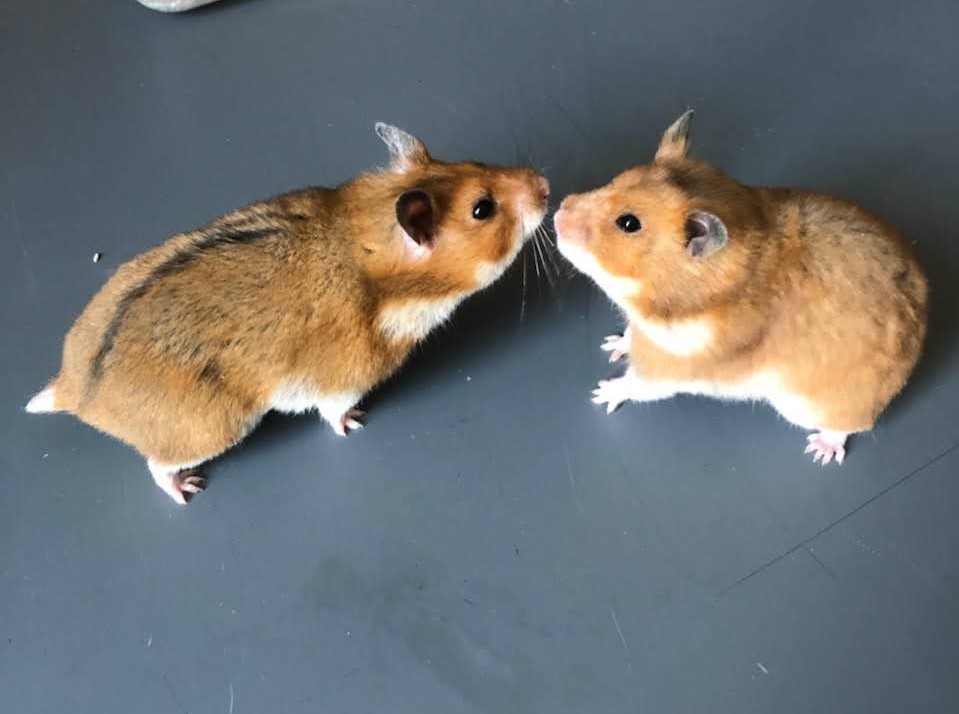Social behavior and communication are key to building relationships in most species. Vasopressin, a neurochemical commonly known for regulating blood pressure and water balance, also plays a critical role in regulating social behavior and communication. Here, we show that deleting vasopressin receptors can lead to behavioral changes that are opposite of what is expected.
Views 4578
Reading time 4 min
published on Aug 30, 2023
Arginine-vasopressin (AVP) is a hormone with a variety of functions, including regulation of blood pressure and water balance. One of the first discoveries of an AVP action in the brain was the finding that it alters social behavior, enhancing a form of social communication in hamsters called flank marking, when injected into specific brain regions. Flank marking is elicited naturally when hamsters are exposed to the scent marks of another hamster: most hamsters will respond by rubbing flank glands to deposit their own scent on top of the older marks.
Activating vasopressin receptors (V1aR) in the same brain regions also increases aggression in males but decreases aggression in female hamsters. Unlike other rodent species, both male and female hamsters exhibit territorial aggression, and both sexes exhibit flank marking at similar rates. Hamster aggression is stereotyped and ritualistic, meaning injuries are extremely rare. This makes hamsters a great animal model for studying social behavior in both males and females.
Gene editing tools enable us to study brain function at the cellular and circuit level. CRISPR-cas9 is an exciting way of manipulating genes because it efficiently and specifically edits DNA and can be used in nearly every vertebrate species. This means that species with interesting social behaviors, like hamsters, can be gene-modified in ways that were not possible with older gene editing tools. Using CRISPR-cas9, we created a strain of Syrian hamsters that were genetically modified to no longer produce V1aR throughout the body and brain. Hamsters born from these genetically modified hamsters that produce V1aR as normal are referred to as “wild-types” because they are genetically identical to hamsters in the wild. Hamsters without any V1aR are referred to as “knockouts”, as all the V1aR are “knocked out”.
Once we produced these genetically modified hamsters, we needed to verify V1aR deletion in knockouts. Using a technique called autoradiography to image the presence or absence of receptors in the brain and other tissues, we confirmed that knockout hamsters do not have any V1aR in the brain. We also confirmed the loss of function associated with V1aR in both the body and brain. AVP helps regulate blood pressure, so we injected AVP into the periphery of knockout and wild-type hamsters. While peripheral injections of AVP increased blood pressure in wild-type hamsters, as expected, knockout hamsters did not respond at all. We also administered V1aR activators or saline, as a control, into the brain of wild-type and knockout hamsters. V1aR activation increased flank marking in wild-types but did not affect flank marking in knockouts. Thus, we can conclude that our CRISPR-cas9gene manipulation caused a physical and functional loss of V1aR in the body and brain.
Now that we confirmed the loss of V1aR in knockout hamsters, how does this impact social behavior? Just as humans have nonverbal cues that convey our social or economic status, confidence, etc., flank marking in hamsters communicates social status and mate choice. Previous pharmacological experiments indicated that V1aR activation is critical for social communication, flank marking, so we expected to see little to no flank marking in V1aR knockout hamsters. Contrary to our expectations, however, we observed robust flank marking in all hamsters, both wildtypes and knockouts, in response to the scent of another hamster. Astonishingly, knockout hamsters flank marked two times more than did wild-types.
Previously, pharmacological activation of V1aR in specific brain regions increased aggression in males but decreased aggression in females, so we expected to see less aggression in male knockout hamsters but more aggression in female knockout hamsters. As with flank marking, however, the behavior of male knockout hamsters was opposite of our prediction: knockout males were more aggressive compared to wild-types. In contrast, the aggressive behavior of female knockouts was consistent with our prediction: knockout females were more aggressive compared to wild-types.
Our study emphasizes the importance of studying whole neural networks. While investigating the role of individual brain regions is important, this alone does not tell the whole story. Using CRISPR-cas9 to delete V1aR throughout the brain, we investigated the role of AVP in an intact, complex network of brain regions that modulate social behavior. Contrary to our expectations, V1aR activation is not necessary for odor-induced flank marking or aggression, and, in fact, V1aR knockout can increase flank marking and aggression rather than decreasing it. These unexpected results are likely due to compensatory changes in signaling that occur across the neurochemical circuits that control these behaviors that are critical for reproduction and survival.
Original Article:
Taylor JH, Walton JC, McCann KE, Norvelle A, Liu Q, Vander Velden JW, Borland JM, Hart M, Jin C, Huhman KL, Cox DN, Albers HE. CRISPR-Cas9 editing of the arginine-vasopressin V1a receptor produces paradoxical changes in social behavior in Syrian hamsters. Proc Natl Acad Sci U S A. 2022 May 10;119(19):e2121037119. doi: 10.1073/pnas.2121037119. Epub 2022 May 5. PMID: 35512092; PMCID: PMC9171636.
 Neurobiology
Neurobiology



